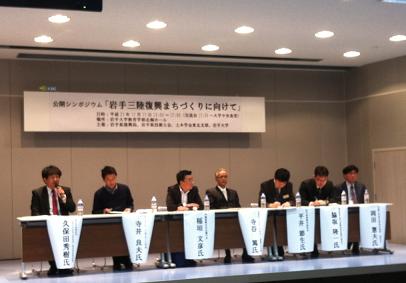SPECIAL vol.8 Attending the “Sanriku Region Machizukuri Symposium” ~Citizen-led Machizukuri and the Government’s Responsibility~ | |
|
An administrative officer’s viewpoint (See also Mr.Teratani’s related report.) Yasubumi Oyama Executive Director, Office of Secretarial and Public Relations, Iwate Prefecture January 18th, 2012 In order to promote recovery from the Great East Japan Earthquake and Tsunami ( ※ ) which occurred on March 11th, 2011, the Iwate Prefectural government developed a Reconstruction Plan on August 11th of that year. Based upon this Prefectural plan, each of the twelve coastal municipalities drew up its own reconstruction plan by the end of last year. This year, consequently, the residents of the area are to take initiative to start their “machizukuri (community vitalization)” toward recovery. Under this circumstance, on December 15th, 2011, I took part in the Sanriku Region Machizukuri Symposium which was open to the public. It was organized by a group including Professor Masaaki Minami of Iwate University, who is also a member of a special committee of Iwate Reconstruction Council. The symposium was held at Iwate University drawing about 200 participants. I would like to report on the second half of the symposium, in which opinions were exchanged on the topic of citizen-led machizukuri toward recovery. First, Dr. Okada, Professor of the Disaster Prevention Research Institute of Kyoto University, made a keynote speech. He introduced a successful case of community re-vitalization from his experience of engaging in the “Japan Zero-to-One Community Vitalization Movement” in Chizu Town, Tottori Prefecture. Although the town faced problems of depopulation and aging, the residents were very active and creative. They developed a unique workshop method named Yonmen Kaigi System (four sided discussion system) to share their vision of their community in ten years’ time, worked on specific projects to achieve the vision, and finally succeeded in reviving the community. After the keynote speech, a panel discussion took place with seven panelists including Dr. Okada, all of whom are working in disaster-affected areas all over Japan as members of a university, NPOs, citizens’ groups, or administrative bodies. First, Mr. Hideki Kubota (a member of an NPO called “Let’s Get Up on our Feet! Taro, Miyako”) from Taro Town in Miyako City, which was seriously damaged in earthquake and tsunami, appealed that they were eager to make a move toward recovery, but did not know what to start with. In response, Mr. Atsushi Teratani (the initiator of the Japan Zero-to-One Community Vitalization Movement in Chizu Town), Mr. Fumihiko Inagaki (Representative of Chuetsu Citizens’ Council for Recovery at the time of the 2004 Chuetsu Earthquake in Niigata Prefecture) and other panelists presented convincing advice supported by real-life examples; “Residents should earnestly develop a vision for their community’s recovery.” “You should not be hesitant to recruit outside experts, if necessary.” “Try to make good use of government support instead of just opposing them.” “It is important to accumulate small experiences of success.” These words gave us courage and a ray of hope, because they were those of the people who had actually overcome the hardships of disaster. This symposium had a lot of participants from places as far as 100 kilometers away within the disaster-affected area, including from the cities of Miyako and Ofunato. This fact indicates that the residents are highly motivated to take initiative to promote machizukuri for recovery, and at the same time that many of them are seeking practical information and suggestions for that. The symposium has made me strongly aware of government’s growing responsibility to provide timely and attentive support to meet their needs, so that each of the communities can promote machizukuri swiftly and revive as an area even more prosperous than before. I would like to extend my sincere gratitude to the organizers, as well as to the speakers and the panelists. ※ As the damages caused by the tsunami were enormous, Iwate Prefecture calls this disaster the “Great East Japan Earthquake and Tsunami” adding tsunami to the official name of the event which the national government designated. ● Panelists of the symposium From left ◇ Mr. Hideki Kubota, Member of NPO “Let’s Get Up on our Feet! Taro, Miyako” (in Taro Town, Miyako City) ◇ Mr. Yoshio Terai, Representative of SAVE IWATE (in Morioka City) ◇ Mr. Fumihiko Inagaki, Representative of Chuetsu Citizens’ Council for Recovery (in Niigata Prefecture) ◇ Mr. Atsushi Teratani, the initiator of the Japan Zero-to-One Community Vitalization Movement, Chizu, Tottori ◇ Mr. Setsuo Hirai, Deputy Director of Bureau of Reconstruction, Iwate Prefecture ◇ Mr. Ryuichi Wakisaka, Urban Senior Coordinator of Tohoku Regional Bureau, Ministry of Land, Infrastructure, and Transport ◇ Dr. Norio Okada, Professor of Disaster Prevention Research Institute of Kyoto University The readers are also invited to visit the following websites. ● Iwate Prefecture’s English web pages regarding the Great East Japan Earthquake and Tsunami ◇ Ganbaro Iwate! (がんばろう!岩手宣言) http://www.pref.iwate.jp/view.rbz?cd=32122 ◇ Iwate Prefecture Great East Japan Earthquake and Tsunami Reconstruction Plan (岩手県東日本大震災津波復興基本計画) http://www.pref.iwate.jp/~hp0212/fukkou_net/fukkoukeikaku_english.html ◇ Basic Reconstruction Plan < Outline >(岩手県東日本大震災津波復興基本計画概要版) http://www.pref.iwate.jp/~hp0212/fukkou_net/pdf_doc/kihonkeikaku_gaiyoh_02.pdf ◇ Charity Donations for the Great Tohoku Earthquake Disaster (東北地方太平洋沖地震義援金) http://www.pref.iwate.jp/view.rbz?cd=32136 ◇ News from Iwate’s Reconstruction (いわて復興だより) http://www.pref.iwate.jp/view.rbz?cd=34866&ik=0&pnp=14 |
